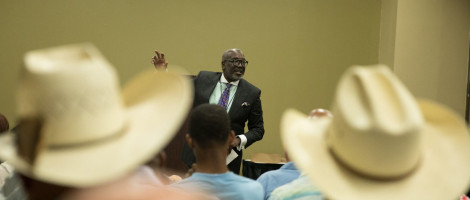By: Bailey Pylant, contributing writer and coordinator for news and social media at Dallas Baptist University
“When we teach, we are dealing with a document written in a first century Eastern culture, being consumed as a 17th century European document by people with a 21st century western mindset. What could go wrong?”
Attempting to communicate truths from Jesus’s time to people living in 2018 has its difficulties, and as Great Commission Director Delvin Atchison described, the margin for error is great.
Illustrating the Gospel
To lessen the effects of this margin, preachers like Atchison turn to helpful devices such as stories and illustrations.
As Atchison expressed to his audience at the 2018 Annual Meeting, “The effective use of illustrations equips us to invite a listener into our world. It helps to make what is weighty, manageable.”
Atchison not only views storytelling as an engagement tool but as necessary for contemporary teaching and preaching. “If you’re going to be an effective teacher, you’ve got to learn to tell stories,” remarked Atchinson.
The 21st century, in particular, keeps individuals begging for stories due to the overwhelming amount of information available and the need for teachers to make sense of an overstimulated culture.
Here lies the helpfulness of illustrations. “Illustrations have a way of relaxing the listener. You relax them while at the same time calling them to a sense of attention. They listen so they can follow the story.”
However, as Atchison reminded, stories cannot simply be applied haphazardly. They must be understandable, pertinent, transition smoothly and have good use of detail.
Understanding the story
“Details make a story credible. Details that are crisp, invite people into our world. But if you have to tell a story to explain your story, don’t tell that story.” Atchison pressed the importance of administering stories with intention.
In addition to their attention grabbing usefulness, stories also help translate truths across cultures. Atchison noted that “People still respect the Bible in Texas, but there are some places where scripture is just viewed as another piece of literature. So, I share illustrations to nail down a truth to then be able to say ‘See! Scripture has been saying this all along.’”
The inerrant word of God does not needaccreditation from human illustrations, but people often need illustrations to help digest weighty truths found in scripture.
As Atchison said, “We’re trying to connect the truth that Jesus spoke then to the life that people live now. To get from the then to the now, we use stories that contain an always truth.”
That said, Atchison provided a few outlets from where to gather applicable stories and encouraged his audience to write out their stories before speaking.
Antidotes, biographies, science and periodicals
Among Atchison’s suggestions of potential stories were personal antidotes, biographies, science and periodicals.
Leading with personal stories, Atchison mentioned the audience’s desire to connect with the humanity of the speaker. However, he cautioned against the pitfalls of personal antidotes by reminding speakers not to always make themselves the hero, to not over exaggerate a story and to limit details to only the pertinent information.
Moving to biographies, Atchinson noted that, “Stories of other people are so significant because they help set the mood about the reality.” Biographical illustrations allow the audience to grapple with truths in a real context but with the benefit of hindsight.
While science is usually viewed in opposition of religion, Atchinson suggested that illustrations for nature can be helpful. He provided an illustration explaining how geese fly in the shape of a “V” so that one goose bears the weight of the wind while the others honk in encouragement. “Wouldn’t it be great if we developed some Galatians 6, geese theology to help each other out?”
The audience responded with chuckles and nods of ascent as Atchison perfectly proved the effectiveness of a story.
News outlets rarely proclaim the good news of the Gospel, but headlines like the New York Daily News,’ “Christ the King Does it Again,” are easy bait. Although it was a story covering the state championship involving the Christ the King Royals, Atchinson leveraged the unintentional pun asking his audience, “Can I get an amen from anyone who can testify that ‘Christ the King has done it again' and saved us from the sin we deserve?’”
Appropriately, Atchinson closed with a story about Gordon and Norma Yeager, a married couple of 72 years that died holding hands. Gordon was pronounced dead an hour before his wife. However, a family member noticed the monitor still indicated a heartbeat and questioned “How can he be dead when he still as a heartbeat?” Gordon had such a tight grip on Norma’s hand that her pulse was registering through the monitor.
Atchinson addressed the crowd saying “I want you to tell stories so that when you’re holding the Lord’s hand so tightly, the congregation can feel His heartbeat through you.”
Texas Baptists is a movement of God’s people to share Christ and show love by strengthening churches and ministers, engaging culture and connecting the nations to Jesus.
The ministry of the convention is made possible by giving through the Texas Baptists Cooperative Program, Mary Hill Davis Offering® for Texas Missions, Texas Baptists Worldwide and Texas Baptist Missions Foundation. Thank you for your faithful and generous support.
Subscribe to receive stories like this one directly to your inbox.
We are more together.
